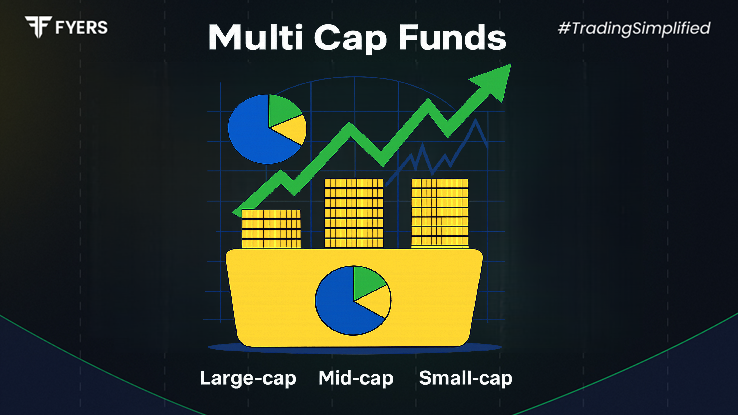

 29 Sep, 2025
29 Sep, 2025
 3 mins read
3 mins read

In the Indian mutual fund space, investors often look for a balance between stability and growth. Multi cap funds are designed to provide just that. They invest across large-cap, mid-cap, and small-cap companies, giving investors diversified exposure within a single fund.
Understanding what are multi cap funds, their features, and performance trends can help investors decide if they suit their portfolio strategy.
A multi cap mutual fund comes with unique characteristics that distinguish it from other equity-oriented schemes:
Diversified Allocation: By mandate, multi cap funds must invest at least 25% each in large-cap, mid-cap, and small-cap stocks.
Balanced Risk and Return: Exposure to large-cap stocks offers stability, while mid and small-cap allocations provide growth potential.
Regulated by SEBI: The Securities and Exchange Board of India (SEBI) has clearly defined rules for allocation, ensuring consistency across funds.
Long-Term Orientation: These funds are more suitable for long-term investors due to higher exposure to volatile mid and small caps.
Equity Taxation: Gains are taxed as per equity fund norms—short-term gains (<12 months) at 15% and long-term gains (>12 months) at 10% beyond ₹1 lakh.
While the basic structure is common, there are types of multi cap funds based on investment approach:
Fund managers select stocks dynamically within SEBI’s allocation rule.
Performance depends on the manager’s stock-picking ability.
Passively tracks a predefined multi cap index.
Lower expense ratio compared to active funds.
Both options provide broad market exposure but differ in cost and flexibility.
Investors often confuse flexi cap and multicap funds, but there is a key distinction:
Multi Cap Funds: Must maintain at least 25% allocation each to large, mid, and small caps.
Flexi Cap Funds: Have complete flexibility to allocate across market caps without restriction.
Hanging question for investors: Do you want a regulated structure (multi cap) or full flexibility (flexi cap)?
Like any investment, multi cap mutual funds have advantages and limitations.
Balanced exposure across market caps.
Reduced concentration risk.
Suitable for long-term wealth creation.
SEBI regulations ensure diversification discipline.
Mandatory allocation to volatile small caps may increase risk.
Less flexibility compared to flexi cap funds.
Returns can fluctuate significantly during market downturns.
When evaluating multi cap fund performance, investors should look at both historical returns and volatility.
Large Cap Contribution: Provides stability, often cushioning losses during market corrections.
Mid and Small Cap Contribution: Drives higher returns during bullish phases.
Performance Trend: Historically, multi cap funds have delivered competitive long-term returns compared to pure large-cap funds, though with higher volatility.
Performance varies across fund houses, making it important to review past records, fund manager strategy, and expense ratios.
Multi cap funds are suitable for:
Long-Term Investors: Those with a horizon of at least 5 years to ride out volatility.
Moderate Risk-Takers: Investors comfortable with a mix of stable and volatile stocks.
First-Time Equity Investors: They provide a one-stop option to gain exposure across market segments.
SIP Investors: Regular contributions can smooth out volatility and enhance returns.
However, investors seeking complete flexibility may prefer flexi cap funds instead.
Multi cap funds offer the best of three worlds—stability from large caps, growth from mid caps, and high return potential from small caps. With SEBI’s mandated allocation, they ensure diversification and reduce concentration risk.
While they are not without limitations, for investors with a long-term horizon and moderate risk appetite, multi cap funds can serve as a core equity allocation in their portfolio.
Not entirely. While multi cap funds include exposure to all market caps, dedicated large-cap or mid-cap funds may still provide more focused performance.
Index funds track a predefined multi cap index passively, while active funds rely on fund managers’ stock selection, which may lead to outperformance or underperformance.
They can work with both, but SIPs are generally recommended to manage volatility and average out costs.
SEBI mandates a minimum of 25% allocation in large, mid, and small caps, ensuring diversification and preventing fund managers from being biased towards one segment.
Calculate your Net P&L after deducting all the charges like Tax, Brokerage, etc.
Find your required margin.
Calculate the average price you paid for a stock and determine your total cost.
Estimate your investment growth. Calculate potential returns on one-time investments.
Forecast your investment returns. Understand potential growth with regular contributions.